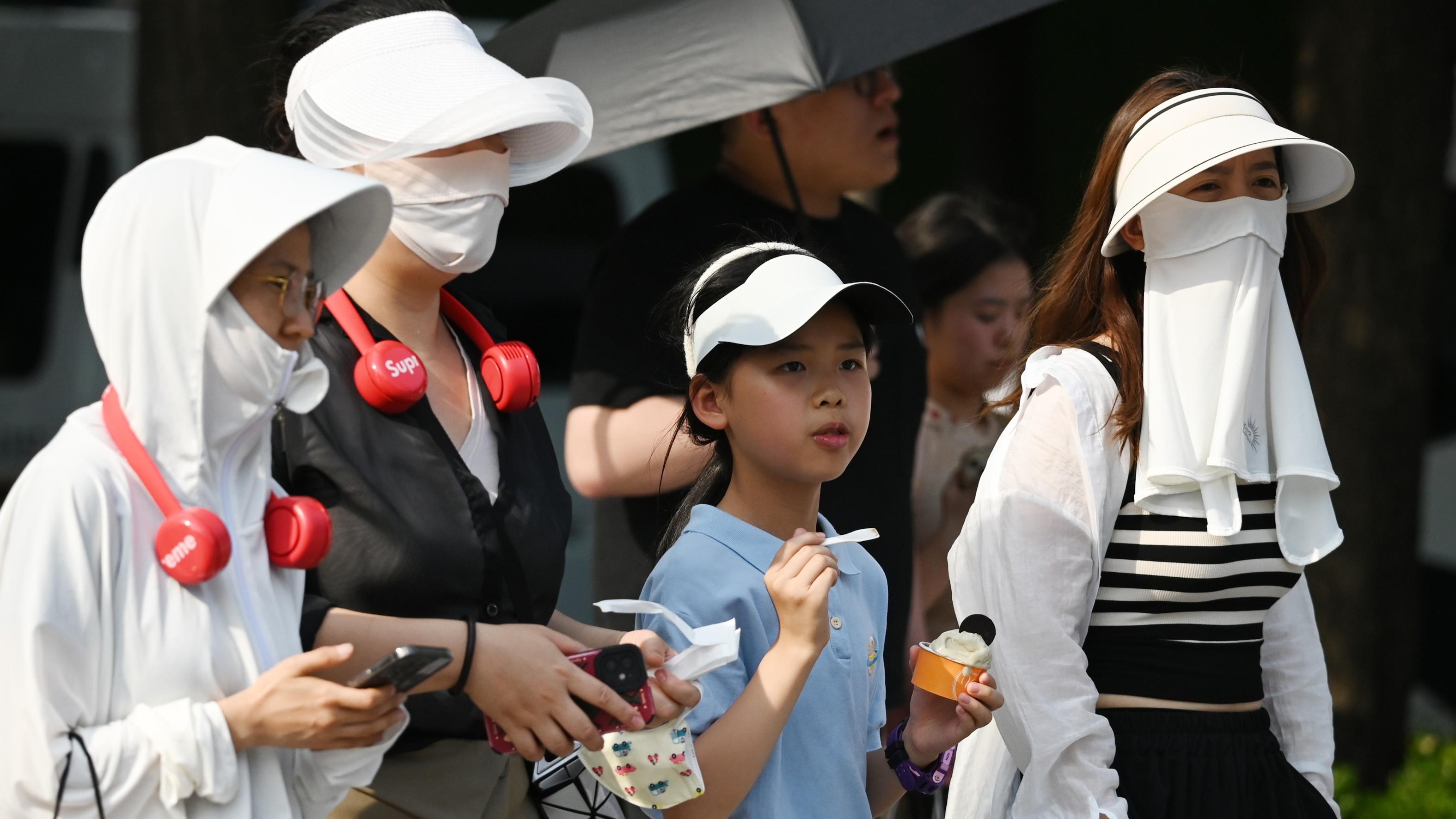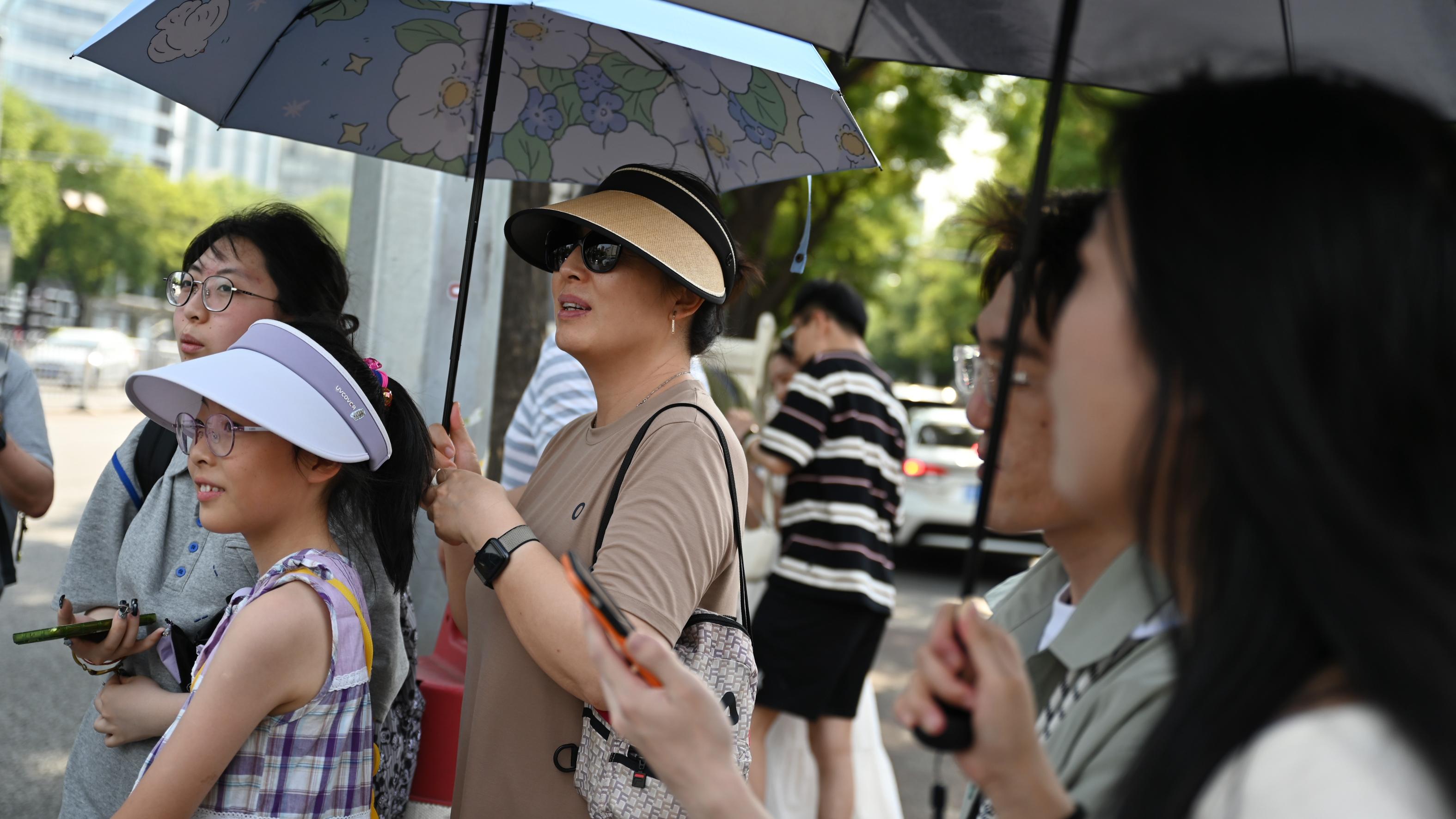 A woman shelters from the sun under an umbrella as she walks past the Forbidden City during a heatwave in Beijing on June 24, 2023. (PHOTO / AFP)
A woman shelters from the sun under an umbrella as she walks past the Forbidden City during a heatwave in Beijing on June 24, 2023. (PHOTO / AFP)
NANJING — China has taken a slew of measures to reduce the impact of fiery heatwaves on people's daily lives as many parts of the country are grappling with scorching temperatures.
China's national observatory on Thursday issued an orange alert, the second-highest alert, for heatwaves, and advised the public to avoid outdoor activities during high-temperature periods.
Since June, many regions in China, including the Beijing-Tianjin-Hebei region and Shandong, have logged high temperatures surpassing 40 degrees Celsius, and the meteorological departments have issued high-temperature alerts.
READ MORE: N. China seeks respite from scorching heat
In southern Beijing, an observatory recorded temperatures above 40 degrees Celsius for three consecutive days for the first time from June 22 to 24.
The number of days with temperatures at or above 35 degrees Celsius in China as of July 2 this year is the highest for the same period since 1961, said China's National Climate Center.
 People wear head coverings during a heatwave in Beijing on June 23, 2023. (PHOTO / AFP)
People wear head coverings during a heatwave in Beijing on June 23, 2023. (PHOTO / AFP)
According to the center, the country is set to see the return of scorching heatwaves for the rest of this month and August in regions including north China and southwest China.
Ensuring power and water supply
The sweltering weather in many places in the country since June has led to a surge in electricity loads.
In particular, 11 regions, such as the Beijing-Tianjin-Hebei region, Shandong and Henan, are experiencing continuous high temperatures, and the peak demand on the whole power grid has arrived ahead of time.
Since summer began, the power load has been rising, with the recent peak load exceeding 900 million kilowatts.
State Grid Corporation of China, the country's major power supplier, has ensured stable power generation, increased power supply from various power sources, and strengthened maintenance of the major power grid and inspection of transmission lines.
In the city of Changzhou, a manufacturing hub in east China's Jiangsu Province, intelligent equipment such as drones and surveillance cameras has been used for problem detection to ensure the normal operation of electrical equipment.
In Beijing, State Grid Beijing Electric Power Company has put more than 200 repair teams and over 100 power generation vehicles on standby in case of electricity emergencies.
To cope with the peak water consumption during hot weather, Tianjin Water Group in north China's Tianjin Municipality has increased the water supply, optimized water transmission lines, and had professional emergency repair teams on 24-hour standby to guarantee the water demand of residents.
 People shelter under umbrellas during a heatwave in Beijing on June 23, 2023. (PHOTO / AFP)
People shelter under umbrellas during a heatwave in Beijing on June 23, 2023. (PHOTO / AFP)
In northeast China's Liaoning province, to combat drought induced by persistent heat, the provincial department of water resources has increased water reserves in some areas in advance to ensure a reliable water supply and guarantee food security in the rice-producing regions.
Protecting people's health
China is not alone in suffering from high temperatures. In early May, parts of several Southeast Asian countries, including Myanmar, Thailand, Laos and Cambodia, saw high temperatures above 40 degrees Celsius, and some places even broke historical records, according to Zhou Bing, a researcher from the National Climate Center.
The likelihood of El Nino developing later this year is increasing, the World Meteorological Organization said in early May.
To help people brace for the blistering heat, Chinese authorities have taken active steps. The disease prevention and control bureau under the National Health Commission issued a guideline on preventing the health hazards of heatwaves, advising people to drink enough water and limit time spent outdoors.
The Ministry of Human Resources and Social Security also urged employers to strengthen health checks for employees, adjust their working hours, and improve working conditions.
In Beijing, urban management and traffic authorities have increased the frequency of spraying water on the roads to reduce ground surface temperatures. The authorities also used more mechanical equipment to reduce manual work during the hottest time of the day.
 A couple shelter from the sun under an umbrella during a heatwave in Beijing on June 23, 2023. (PHOTO / AFP)
A couple shelter from the sun under an umbrella during a heatwave in Beijing on June 23, 2023. (PHOTO / AFP)
In Xuanwu District of Nanjing, the capital of Jiangsu, the local government has launched a service station powered by rooftop photovoltaic panels in a scenic spot. Equipped with air conditioners, medical kits and water dispensers, the station has become a resting place for tourists and outdoor workers.
"The weather is very hot, but we can come to the station to have some water and enjoy the air conditioning. It's very comfortable," said Wang Qiang, a local street cleaner.
Across the country, many more outdoor workers have also received proper care.
READ MORE: China strives to secure power supply amid heatwaves
Some delivery service companies and food delivery platforms have set up heat stroke prevention stations, providing delivery workers with sun-proof clothing, beverages and medicines, and optimizing delivery routes to minimize the time they spend outdoors.
At a construction site in Cangzhou City, north China's Hebei Province, volunteers have sent watermelons, bottled water, and other cooling supplies to the workers for a drainage renovation project.
"We will adjust working time and rest breaks and take effective measures to improve ventilation, heat insulation and cooling systems in the workplaces to beat the heat together," said Liu Qiang, an official with the housing and urban-rural development bureau of Mengcun Hui Autonomous County in Cangzhou.


